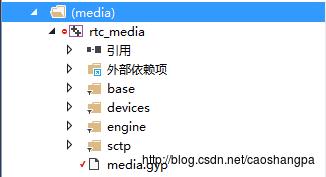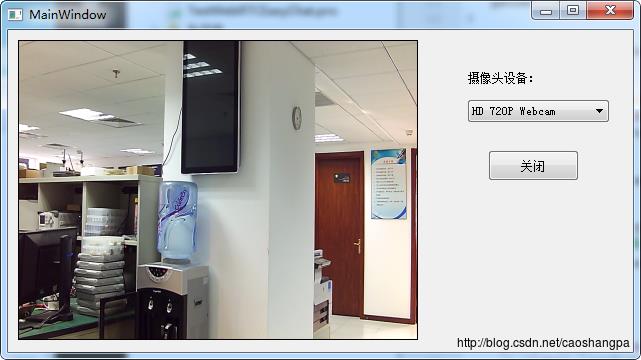WebRTC学习之九:摄像头的捕捉和显示
Posted 草上爬
tags:
篇首语:本文由小常识网(cha138.com)小编为大家整理,主要介绍了WebRTC学习之九:摄像头的捕捉和显示相关的知识,希望对你有一定的参考价值。

上图中base目录中是一些抽象类,engine目录中是对应抽象类的实现,使用时直接调用engine目录中的接口即可。WebRtcVoiceEngine实际上是VoiceEngine的再次封装,它使用VoiceEngine进行音频处理。注意命名,WebRtcVideoEngine2带了个2字,不用想,这肯定是个升级版本的VideoEngine,还有个WebRtcVideoEngine类。WebRtcVideoEngine2比WebRtcVideoEngine改进之处在于将视频流一分为二:发送流(WebRtcVideoSendStream)和接收流(WebRtcVideoReceiveStream),从而结构上更合理,源码更清晰。
本文的实现主要是使用了WebRtcVideoEngine2中WebRtcVideoCapturer类。
一.环境
参考上篇:WebRTC学习之三:录音和播放
二.实现
打开WebRtcVideoCapturer的头文件webrtcvideocapture.h,公有的函数基本上都是base目录中VideoCapturer类的实现,用于初始化设备和启动捕捉。私有函数OnIncomingCapturedFrame和OnCaptureDelayChanged会在摄像头采集模块VideoCaptureModeule中回调,将采集的图像传给OnIncomingCapturedFrame,并将采集的延时变化传给OnCaptureDelayChanged。
WebRTC中也实现了类似Qt中的信号和槽机制,详见WebRTC学习之七:精炼的信号和槽机制 。但是就像在该文中提到的,sigslot.h中的emit函数名会和Qt中的emit宏冲突,我将sigslot.h中的emit改成了Emit,当然改完之后,需要重新编译rtc_base工程。
VideoCapturer类有两个信号sigslot::signal2<VideoCapturer*, CaptureState> SignalStateChange和sigslot::signal2<VideoCapturer*, const CapturedFrame*, sigslot::multi_threaded_local> SignalFrameCaptured,从SignalFrameCaptured的参数可以看出我们只要实现对应的槽函数就能获取到CapturedFrame,在槽函数中将 CapturedFrame进行转换显示即可。SignalStateChange信号的参数CaptureState是个枚举,标识捕捉的状态(停止、开始、正在进行、失败)。
信号SignalFrameCaptured正是在回调函数OnIncomingCapturedFrame中发射出去的。OnIncomingCapturedFrame里面用到了函数的异步执行,详见WebRTC学习之八:函数的异步执行。
mainwindow.h
#ifndef MAINWINDOW_H
#define MAINWINDOW_H
#include <QMainWindow>
#include <QDebug>
#include <map>
#include <memory>
#include <string>
#include "webrtc/base/sigslot.h"
#include "webrtc/modules/video_capture/video_capture.h"
#include "webrtc/modules/video_capture/video_capture_factory.h"
#include "webrtc/media/base/videocapturer.h"
#include "webrtc/media/engine/webrtcvideocapturer.h"
#include "webrtc/media/engine/webrtcvideoframe.h"
namespace Ui {
class MainWindow;
}
class MainWindow : public QMainWindow,public sigslot::has_slots<>
{
Q_OBJECT
public:
explicit MainWindow(QWidget *parent = 0);
~MainWindow();
void OnFrameCaptured(cricket::VideoCapturer* capturer, const cricket::CapturedFrame* frame);
void OnStateChange(cricket::VideoCapturer* capturer, cricket::CaptureState state);
private slots:
void on_pushButtonOpen_clicked();
private:
void getDeviceList();
private:
Ui::MainWindow *ui;
cricket::WebRtcVideoCapturer *videoCapturer;
cricket::WebRtcVideoFrame *videoFrame;
std::unique_ptr<uint8_t[]> videoImage;
QStringList deviceNameList;
QStringList deviceIDList;
};
#endif // MAINWINDOW_H
#include "mainwindow.h"
#include "ui_mainwindow.h"
MainWindow::MainWindow(QWidget *parent) :
QMainWindow(parent),
ui(new Ui::MainWindow),
videoCapturer(new cricket::WebRtcVideoCapturer()),
videoFrame(new cricket::WebRtcVideoFrame())
{
ui->setupUi(this);
getDeviceList();
}
MainWindow::~MainWindow()
{
delete ui;
videoCapturer->SignalFrameCaptured.disconnect(this);
videoCapturer->SignalStateChange.disconnect(this);
videoCapturer->Stop();
}
void MainWindow::OnFrameCaptured(cricket::VideoCapturer* capturer,const cricket::CapturedFrame* frame)
{
videoFrame->Init(frame, frame->width, frame->height,true);
//将视频图像转成RGB格式
videoFrame->ConvertToRgbBuffer(cricket::FOURCC_ARGB,
videoImage.get(),
videoFrame->width()*videoFrame->height()*32/8,
videoFrame->width()*32/8);
QImage image(videoImage.get(), videoFrame->width(), videoFrame->height(), QImage::Format_RGB32);
ui->label->setPixmap(QPixmap::fromImage(image));
}
void MainWindow::OnStateChange(cricket::VideoCapturer* capturer, cricket::CaptureState state)
{
}
void MainWindow::getDeviceList()
{
deviceNameList.clear();
deviceIDList.clear();
webrtc::VideoCaptureModule::DeviceInfo *info=webrtc::VideoCaptureFactory::CreateDeviceInfo(0);
int deviceNum=info->NumberOfDevices();
for (int i = 0; i < deviceNum; ++i)
{
const uint32_t kSize = 256;
char name[kSize] = {0};
char id[kSize] = {0};
if (info->GetDeviceName(i, name, kSize, id, kSize) != -1)
{
deviceNameList.append(QString(name));
deviceIDList.append(QString(id));
ui->comboBoxDeviceList->addItem(QString(name));
}
}
if(deviceNum==0)
{
ui->pushButtonOpen->setEnabled(false);
}
}
void MainWindow::on_pushButtonOpen_clicked()
{
static bool flag=true;
if(flag)
{
ui->pushButtonOpen->setText(QStringLiteral("关闭"));
const std::string kDeviceName = ui->comboBoxDeviceList->currentText().toStdString();
const std::string kDeviceId = deviceIDList.at(ui->comboBoxDeviceList->currentIndex()).toStdString();
videoCapturer->Init(cricket::Device(kDeviceName, kDeviceId));
int width=videoCapturer->GetSupportedFormats()->at(0).width;
int height=videoCapturer->GetSupportedFormats()->at(0).height;
cricket::VideoFormat format(videoCapturer->GetSupportedFormats()->at(0));
//开始捕捉
if(cricket::CS_STARTING == videoCapturer->Start(format))
{
qDebug()<<"Capture is started";
}
//连接WebRTC的信号和槽
videoCapturer->SignalFrameCaptured.connect(this,&MainWindow::OnFrameCaptured);
videoCapturer->SignalStateChange.connect(this,&MainWindow::OnStateChange);
if(videoCapturer->IsRunning())
{
qDebug()<<"Capture is running";
}
videoImage.reset(new uint8_t[width*height*32/8]);
}
else
{
ui->pushButtonOpen->setText(QStringLiteral("打开"));
//重复连接会报错,需要先断开,才能再次连接
videoCapturer->SignalFrameCaptured.disconnect(this);
videoCapturer->SignalStateChange.disconnect(this);
videoCapturer->Stop();
if(!videoCapturer->IsRunning())
{
qDebug()<<"Capture is stoped";
}
ui->label->clear();
}
flag=!flag;
}
#include "mainwindow.h"
#include <QApplication>
int main(int argc, char *argv[])
{
QApplication a(argc, argv);
MainWindow w;
w.show();
while(true)
{
//WebRTC消息循环
rtc::Thread::Current()->ProcessMessages(0);
rtc::Thread::Current()->SleepMs(1);
//Qt消息循环
a.processEvents( );
}
}三.效果


以上是关于WebRTC学习之九:摄像头的捕捉和显示的主要内容,如果未能解决你的问题,请参考以下文章